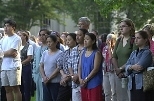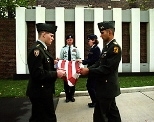The American flag in MIT's Killian Court was lowered to half-staff on Sept. 11 at the exact time the first airplane struck the World Trade Center a year ago, beginning MIT's day of remembrance.
The MIT Chapel bell started ringing in unison with bells throughout Cambridge at 8:46 a.m. At the first faint hint of a chime, the flag began its slow descent and the MIT Police color guard snapped to attention. At that moment, the roar of a plane from Logan Airport and the siren of a passing ambulance were more noticeable than the bells.
At about 8:30, people emerged from the buildings and sidewalks and stood quietly in a semicircle on the grass. More than 200 participated in the event.
Some stood alone, some talked with colleagues and friends, a few couples held each other silently. Some wore their patriotism in the form of red, white and blue scarves, pins or American flag patterns sewn onto T-shirts. A few men throughout the crowd stood with legs apart, hands clasped at their backs, staring straight ahead like soldiers at ease.
VEST RECALLS THE DAY
It grew very quiet as the color guard assembled at the flagpole's base near the Henry Moore sculpture. After a silence during which Memorial Drive's rumble of traffic seemed to grow to a roar, President Charles Vest stepped to the microphone and solemnly recalled how MIT was at work and study a year ago as that day's horrific events unfolded throughout the morning.
"Becky and I had the misfortune to be out of the country that day [on a trip to the Canadian Rockies]," he said. "We deeply missed the strong sense of feeling of community and the chance to physically reach out and touch all of you at that time." He said the calm beauty of the mountains surrounding him belied the horror of the constant stream of news he received that day.
Vest, who visited Ground Zero on Sept. 10, described it as "an enormous planar void in the heart of New York City." He said that as he looked at the items of remembrance that people from all over the country and the world had left near the site, he noticed that the hustle and bustle of the city continued around him. Members of the MIT community, too, he said, should support each other and "go about the business of educating people to use their gifts and capabilities and knowledge for the betterment of our world.
"Let us begin this day remembering the horrible events of a year ago and honoring those whose lives were taken," he said.
With dignity and solemnity, the regiment of police retreated to Memorial Drive and the crowd slowly dispersed. The flag, which had been limply wrapped around the pole until that moment, suddenly unfurled, lifted by an unseen gust of air.
A version of this article appeared in MIT Tech Talk on September 18, 2002.







